The Old Union Depot in East Dallas: 1897-1935
by Paula Bosse
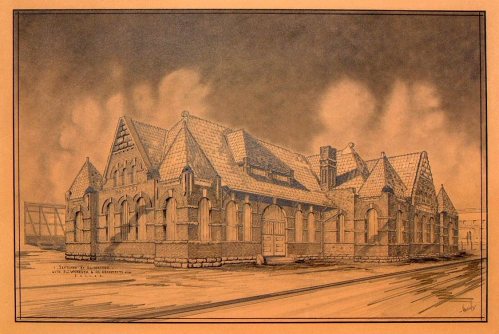 From the collection of Art Hoffman (click for larger image)
From the collection of Art Hoffman (click for larger image)
by Paula Bosse
I saw the above rendering of the old East Dallas rail depot posted recently in a Dallas history group. It was bought several years ago by Art Hoffman who was told it had belonged to a former employee of the Houston & Texas Central Railroad (which, along with the Texas & Pacific, served this station). It’s an odd thing for an architect to sketch — a boarded-up railroad depot. I couldn’t find anything on E. L. Watson, the architect who did the rendering (perhaps a member of the Watson family who were prominent Dallas contractors?), and I couldn’t find any connection between the depot and the F. J. Woerner & Co. architectural firm. The drawing might have been done in 1931, with what looks like “31” next to the artist’s signature. Could the drawing have been done merely as a study for E. L. Watson’s portfolio?
But back to the building itself. It was referred to by all sorts of names: Union Station, Union Depot, East Dallas Depot, Old Union Station, etc. With all these permutations, it took considerable digging to determine exactly when it had been built and when it had been demolished.
A couple of stations had previously occupied this site (about where Pacific Avenue and Central Expressway would cross), the first being built in 1872 at the behest of William H. Gaston who was developing the area, well east of the Dallas city limits. Due to the presence of the railroad, the area grew quickly, and in 1882, it was incorporated as the city of East Dallas. It thrived and continued to grow and on January 1, 1890 it was annexed and became part of the city of Dallas.
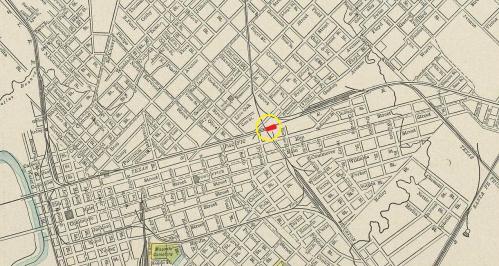 Location of depot in red — map circa 1890-1900 (click to enlarge)
Location of depot in red — map circa 1890-1900 (click to enlarge)
The depot pictured in the drawing above was built in 1897. The previous station, a woefully inadequate and outdated “shanty,” was, by early 1897, being nudged toward demolition in order to remain competitive with the new Santa Fe depot then under construction. In the Feb. 10, 1897 edition of The Dallas Morning News, it was referred to as “the present eye-sore in East Dallas” which would be better off “abandoned and used for kindling wood.”
On April 4, 1897, it was reported that plans for a new Texas & Pacific passenger depot were nearly completed. By the beginning of June, the shanty had been torn down, and on June 6, 1897, the drawing below appeared in the pages of the Morning News, giving the people of Dallas a first look at what the much grander station would look like when completed. (It’s unfortunate that the actual architectural rendering was not used, but, instead, a more rudimentary staff artist’s version was printed.) The accompanying information revealed that the new depot had been designed by Mr. O. H. Lang, an architect who worked in the engineering department of the Texas & Pacific Railroad. This was an exciting tidbit to find, because I had wondered who had designed the structure but had been unable to find this elusive piece of information. And it was Otto Lang! Eight years after designing this railroad depot, Lang and fellow architect Frank Witchell would form the legendary firm of Lang & Witchell, and they would go on to design some of Dallas’ most impressive buildings.
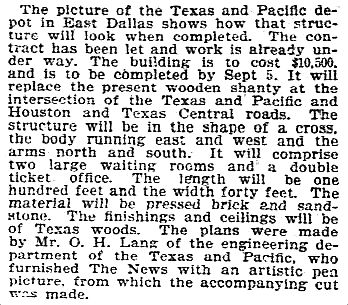 Dallas Morning News, June 6, 1897
Dallas Morning News, June 6, 1897
The building was completed fairly quickly, and its official opening was announced on Oct. 12, 1897.
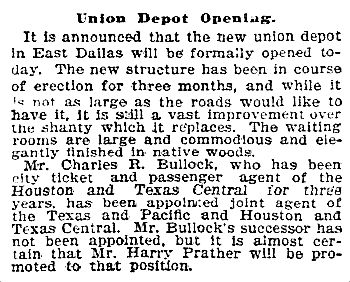 DMN, Oct. 12, 1897
DMN, Oct. 12, 1897
Here’s what the station looked like soon after it opened for business, from an 1898 Texas & Pacific publication (click for larger images):
Much better than a shanty!
Below in another early photo of the depot:
Can’t pass up an opportunity of zooming in on a detail:
Here it is around 1910, a hotbed of activity, now with the addition of automobiles:
The station served an important role in the growth of (East) Dallas and in the everyday lives of its residents for almost twenty years, but in 1916 the many “independent” passenger and freight depots that had been spread out all over town were shuttered, per the Kessler Plan’s directive to consolidate and run all the rail lines in and out of the new Dallas Union Terminal. (This was when the word “old” began appearing ahead the East Dallas station whenever it was mentioned.)
So what became of the East Dallas depot? From “Relic of City of East Dallas Being Demolished,” a Dallas Morning News article from Jan. 20, 1935:
Last use of the depot for railroad purposes came in 1933 when it was abandoned as a freight station in August of that year. After that it was used as a station for interviewing destitute clients for the relief board but for several months has been boarded up.
So that original rendering may not have been done in 1931 after all (unless it was a high-concept architect’s vision of what the depot would look like one day all boarded up…).
At some point it was determined that the station would be torn down. It may have been one of those beautify-the-city projects done in preparation for the Texas Centennial Exposition the next year, but it was probably time for the building to come down. It was January of 1935, at the height of the Great Depression, and not only did the city make it a point to hire laborers on relief to assist in the demolition, but it also approved the use of salvaged materials from the site to be used in building homes for “destitute families.”
Relief Administrator E. J. Stephany received approval Saturday of a project to get men to tear down the old structure and use the materials in building homes for destitute families and work is expected to start immediately. (“East Dallas Station To Be Torn Down and Converted Into Homes,” DMN, Jan. 13, 1935)
Demolition of the depot — which The News called “The Pride of the Gay Nineties” — began on January 18, 1935. The first solemn paragraph of an article reporting on the razing of the landmark is below.
Shorn of all the dignity it possessed for years as the East Dallas Union Depot, the old red structure near the intersection of Central and Pacific avenues began crumbling beneath the blows of wrecking tools wielded by laborers from the Dallas County relief board Friday.” (“Relic of City of East Dallas Being Demolished,” DMN, Jan. 20, 1935)
The red stone slabs bearing the word “Dallas” (3 feet long, 18 inches thick) were offered to the Dallas Historical Society “for safekeeping.”
So did that relief housing get built? Sort of. All I could find was an article from June, 1935, which states that one little building was constructed with some of the brick and stone from the razed depot. It wasn’t a house for the needy but was, instead, headquarters for relief caseworkers in donated park land in Urbandale. Presumably there was housing built somewhere, but all that brick and stone salvaged from the old depot may not have been used for its intended purpose. BUT, there is this tantalizing little tidbit:
As a reminder of the historic antecedent, the new structure [in Urbandale Park] has as a headpiece for its fireplace the large carved stone bearing the name Dallas. (“Relief Structure Made of Materials From Razed Depot,” DMN, June 20, 1935)
Does this mean that the Dallas Historical Society might still have the second slab? If not, what happened to it?
I checked Google Maps and looked at tiny Urbandale Park at Military Parkway and Lomax Drive, just east of S. Buckner, but I didn’t see anything, so I assume the building came down at some point. (UPDATE, 3/20/16: Finally got around to driving to this attractive park. Sadly, the little building is no longer there.)
It would have been nice if that little bit of the old depot had survived — a souvenir of an important hub of activity which sprang to life when memories were still fresh of East Dallas being its own separate entity — the “David” Dallas to its neighboring “Goliath” Dallas. I would love to learn more about what might have happened to that “Dallas” sign which, for a while, hung over the fireplace of an odd little building in an obscure park in southeast Dallas where it lived out its days in retirement.
**
Since I keep adding photos of the depot to this post, I’m going to just start putting new additions (with captioned and linked sources) here:
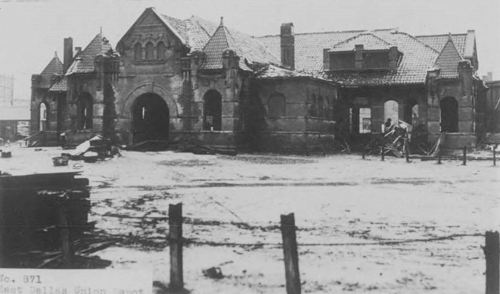 DeGolyer Library, SMU
DeGolyer Library, SMU
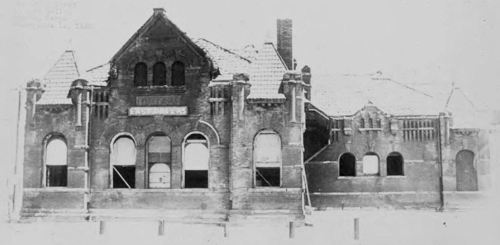 DeGolyer Library, SMU
DeGolyer Library, SMU
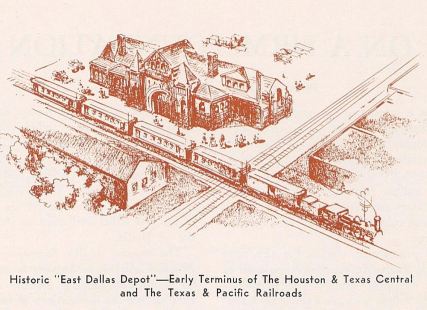
“Your Dallas of Tomorrow” (1943), Portal to Texas History
***
Sources & Notes
Original rendering of the old Union Depot at East Dallas by E. L. Watson is from the collection of Art Hoffman, used with his permission.
More on architect Frank J. Woerner (who designed, among other things, the Stoneleigh Hotel), here (see p. 10 of this PDF).
History of Old East Dallas (and the city of East Dallas), here and here.
More on architects Lang & Witchell here, with an incredible list of some of the buildings designed by their firm here.
1898 photos of the depot’s exterior and interior from Texas, Along the Line of the Texas & Pacific Ry. (Dallas: Passenger Department of the Texas & Pacific Railway, [1898]).
Photo immediately following the photos from the T & P book is from a postcard, found on Flickr, here.
Photo (and accompanying detail) immediately following that is from Dallas Rediscovered by William L. McDonald (Dallas: Dallas Historical Society, 1978). (McDonald identifies the photo as being “c. 1890” — well before the station was built in 1897.) From the collection of the Dallas Historical Society.
Photo of the depot with automobiles is a detail of a larger photograph from the collection of George A. McAfee photographs in the DeGolyer Library, Central University Libraries, Southern Methodist University. The original can be seen here.
Photograph dated 1916 from The Museum of the American Railroad, via the Portal to Texas History site, here.
More information in these Dallas Morning News articles:
- “East Dallas Station To Be Torn Down and Converted Into Homes” (DMN, Jan. 13, 1935)
- “Relic of City of East Dallas Being Demolished” (DMN, Jan. 20, 1935) — very informative
- “Historical Society Will Be Given Slabs of Former Station” (DMN, Jan. 31, 1935)
- “County Gets Land To Install Relief Depot; Later Park” (DMN, Feb. 27, 1935
- “Relief Structure Made of Materials From Razed Depot; Station Occupies Land in Urbandale Donated to County For Park” (DMN, June 20, 1935)
- “Salvaged Materials Go Artistic” (DMN, June 20, 1935) — photo of “relief structure” which accompanied above article
More photos of this immediate area can be found in these posts:
- “The Union Depot Hotel Building, Deep Ellum — 1898-1968,” here
- “The Gypsy Tea Room, Central Avenue, and the Darensbourg Brothers,” here
Many of the pictures and articles can be clicked for larger images.
*
Copyright © 2014 Paula Bosse. All Rights Reserved.

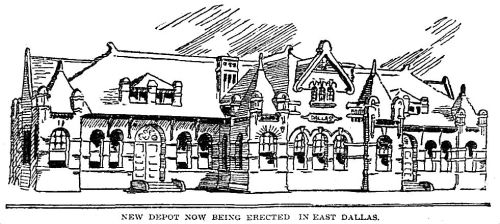
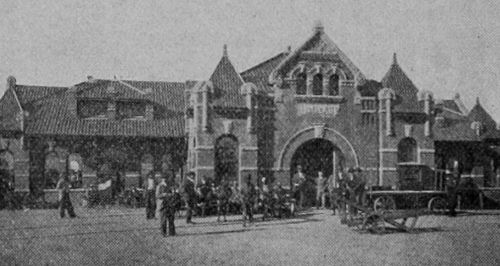
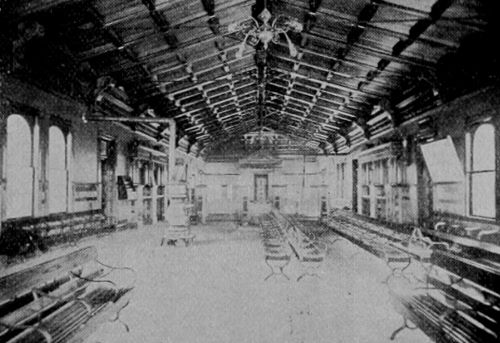
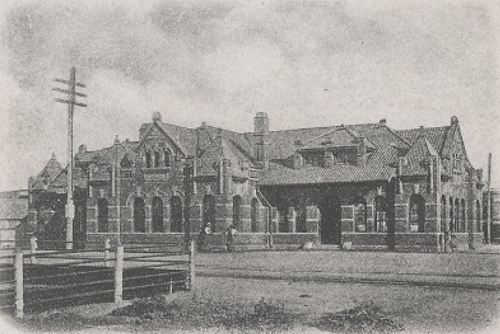

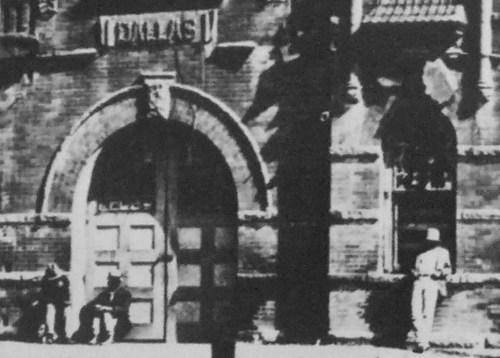
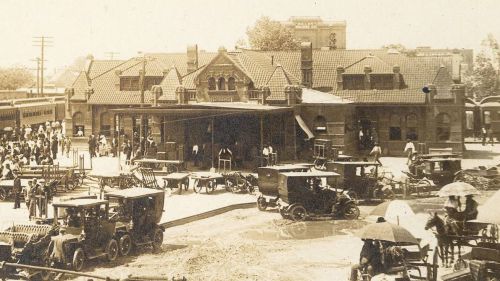
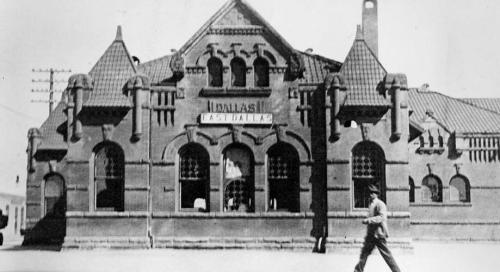
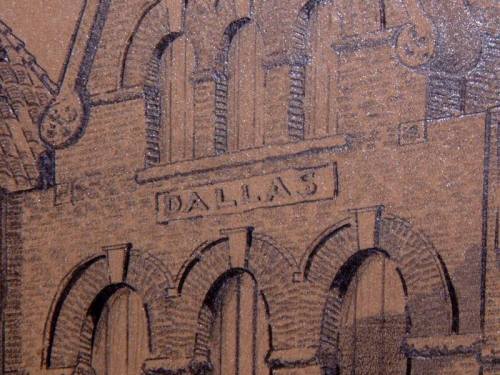
Very interesting! I would have liked to see a map of where it once stood.
LikeLike
Thanks, Alfredo! You’re right — a map would be helpful — I just added one above.
LikeLike
Thank you Paula for answering a long-standing personal question. In the early 1950s while checking out the scene along pawn shop row on the south side of Elm Street I noticed a curious narrow alley running diagonally southeast between Elm and Main streets. This alley (shown clearly in your map) was unpaved and looked like it might have been where a rail line had once run. Across Elm to the north was nothing I can recall clearly; across from the south (Main Street) end was Doran Chevrolet. Later I learned it was the old H & TC right of way and that there had been a station somewhere to the north. Never could find a picture (or exact location) of the station, but now you’ve taken care of that. Thanks again!
LikeLike
Glad I could help with a nagging question, Bob! Old maps of the city come in handy to see so many things that don’t exist anymore. So many street names have changed since that map above. And it really is surprising to see how many of the old train tracks ran THROUGH the city rather than around it.
LikeLike
Great report on an interesting Dallas building of yore! Before Dallas Union Terminal opened in October 1916, there were five separate depots in town–three of which were often called “Union Depot.” It gets confusing for us in the 21st century.
The five are all gone now except maybe the Cotton Belt depot on Lamar. I wonder how much of the Greyhound bus depot might be remnants of the Cotton Belt depot. Hmmm….
I have maps of a lot of the old trackage that threaded through Dallas. Part of the Kessler plan was to get rid of some of it, elevate some, and build a belt railroad around the city.
LikeLike
Thanks, Dennis. I came across bits and pieces of that while I was reading about the East Dallas station. One of the things I never thought about — since I didn’t grow up in the old passenger train-era — was that there were separate stations for freight and passenger trains. Sounds obvious when I think about it, but, like I say, I had never even considered that.
LikeLike
Here’s a link to an architectural drawing for the Santa Fe depot:
http://pixels.com/featured/-passenger-depot-for-the-gulf-colorado-and-santa-fe-railway-in-dallas-texas-perkins-and-adams-architects.html
Only this was not the plan actually chosen for implementation in the late 1890s for construction of a passenger depot on Commerce St.
LikeLike
Great drawing — thanks, Dennis!
LikeLike
I’ll bet you author/speaker Rose-Mary Rumbley might know the fate of the Urbandale Park structure made from materials of the demolished depot. She wrote a book about Dallas parks. I hear she’s a very charismatic person.
LikeLike
Location is Pacific @ Central road intersection. At the time that was a railroad intersection – Texas & PACIFIC and the Houston and Texas CENTRAL hence the names for the streets.
LikeLike
Yes, separate passenger and freight depots were common except in smaller communities where the two were often incorporated into one combined structure.
Recall that the Katy freight depot in the West End was in the news just a few years ago when it was illegally demolished.
The Southern Pacific built a new freight depot at Canton St. in 1936 or so. A historical plaque was placed on the building at the time I wonder what happened to the plaque. The depot was demolished in the last twenty years.
Lots of railroad archaeology in Dallas: The freight tunnels, the old turntable pit exhumed in the West End, the two Dallas Union Terminal interlocking towers, the old T&P advertisement painted on the side of a building in Deep Ellum, and more.
LikeLike
[…] “The Old Union Depot in East Dallas: 1897-1935.” I know nothing about trains, but I found all of this fascinating. The most-researched thing I wrote all year. […]
LikeLike
Excellent job Paula! Thank you for this and all your great work!
LikeLike
Thanks so much, Debby!
LikeLike
[…] “The Old Union Depot in East Dallas: 1897-1935.” I kind of slaved over this one, so I’m happy it was so […]
LikeLike
[…] My previous post, “The Old Union Depot in East Dallas: 1897-1935″ — a history of the station with several photos — can be found here. […]
LikeLike
[…] A related Flashback Dallas post — “The Old Union Depot in East Dallas: 1897-1935” — can be read here. […]
LikeLike
“a detail of a larger photograph by George McAfee, circa 1910,” I don’t think McAfee took that shot, but rather found it in the DMN files
LikeLiked by 1 person
Thanks! I corrected that.
LikeLike
From the 8/12/1882 Callahan County Clarendon: “three car loads of our fine building stone were shipped this week for Dallas to be used in the construction of the union depot to be built there.” Do you know which depot this would have been?
LikeLike
I believe there were 3 H&TC depots in Dallas at the same site over time. The one you cite was probably the 1880s H&TC version or second one. The third one was the version we see photos of most often. It stood until 1935 and was in service until 1916.
If you look at Dallas Sanborn maps you can see the evolution of the depot’s outline over time.
LikeLike
Thank you, Dennis
LikeLike
[…] “The Old Union Depot in East Dallas: 1897-1935,” here […]
LikeLike
Great article! Safely it was taken down when it should have been preserved!
LikeLike
[…] This area — which many have described as being the very heart of Deep Ellum in the 1920s through the 1940s (and which was somewhat ironically referred to as “the gay white way of the Negro in Dallas” by an uncredited WPA writer) — was demolished to make way for the construction of North Central Expressway (which closely followed the H&TC Railway tracks). This photo was taken in the 200 block of North Central Avenue, looking south toward Elm (the building farthest in the background, jutting out to the left, is across Elm, on the south side of the street). To the immediate left of this photo (out of frame) was the old union depot (read about it here). […]
LikeLike
[…] and feel a weird kinship with: the abandoned and shuttered old Union Depot (which I wrote about here) and the Union Depot Hotel (which I wrote about here) — located about where Pacific takes a […]
LikeLike
[…] the photographer) was Pacific. Someone walking out of the Gypsy Tea Room would have been facing the old train depot. Between the depot and the block of businesses were railroad tracks (not in frequent use in the […]
LikeLike
Come to find out, the T&P used the East Dallas Union Depot for passenger service up until 1921 when the T&P mainline on Pacific Ave. was severed. Period newspapers verify this!
LikeLike
That’s me!
LikeLike